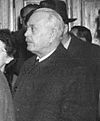Hungarian Parliament
| National coat of arms | Front view |
|---|---|

|

|
| Basic data | |
| Seat: | Parliament building in Budapest |
| Legislative period : | four years |
| MPs: | 199 |
| Current legislative period | |
| Last choice: | April 8, 2018 |
| Chair: | László Kövér ( Fidesz ) |
| Distribution of seats: |
Government (133)
|
| Website | |
| www.parlament.hu | |
The Hungarian Parliament ( Országgyűlés in Hungarian ) is a unicameral parliament based in Budapest . It has consisted of 199 members since 2014 and is directly elected by the people every four years. The Reichstag has been meeting in the Hungarian parliament building since 1902 .
Electoral system
The electoral system is a combination of majority and proportional representation. In 2011 the electoral system was changed significantly and the majority electoral element was strengthened.
Electoral system until 2011
The voters had two votes : one for a direct candidate in 176 single- seat constituencies and one for regional lists in multi- seat constituencies of different sizes (4–28 seats, altogether 152 seats). Seats are awarded for full droop quotas ; remaining seats go to the lists with the most remaining votes , as long as these account for more than two thirds of a quota; otherwise these seats go to the quota for national lists, which consists of a base of 58 mandates.
An absolute majority of the valid votes was necessary in the single electoral districts; Otherwise there will be a runoff , for which all candidates qualify with at least 15% of the valid votes, but at least the 3 strongest candidates. However, the candidates could forego participation in order to increase someone else's chances.
The distribution to the national lists was based on residual votes according to D'Hondt . The remaining votes are, on the one hand, the votes cast in the singles' constituencies in the first ballot to candidates who are on a national list and who have not received a mandate, and, on the other hand, the remaining votes in the distribution to the regional lists. The latter were negative if a remaining mandate was awarded for less than a full quota.
In the distribution of seats outside of the single constituencies, only lists that have received more than 5% of the valid national regional list votes took part . Joint or linked lists of 2 parties had to reach 10%, lists of several parties 15%. When calculating the quota in the multi-mandate constituencies, however, these lists are not excluded, so that there are regularly some remaining mandates .
If the turnout in the first ballot was not greater than 50%, the result was invalid up to and including the 1998 election and a second ballot will take place. In the single constituencies there was no runoff. In the second ballot, a turnout of more than 25% is required. Otherwise there was a by-election in the single-electoral districts and no remaining votes; the mandates of the regional constituencies were then transferred to the national contingent and the votes from the first ballot were counted as remaining votes.
The residual vote system leads to a limited balance . Votes to a successful direct candidate have a much higher success value than votes to inferior candidates, which are nevertheless not completely ignored. The value of the remaining votes from the regional constituencies depended in a complex way on the election result, but tended to be lower than that of the votes that were directly used. Overall, it is an electoral system that (locally) strongly favors larger parties; however, it was far removed from pure majority voting .
Electoral system from 2011
The electoral system, which had not changed much since 1990, was fundamentally reformed in 2011. The main changes were:
- The size of parliament was almost halved from 386 to 199 seats.
- In the constituencies, whose number was reduced from 176 to 106, a relative majority is enough to win in the first ballot. The proportion of directly elected MPs rose from 45.6% to 53.3%, which strengthened the majority electoral element.
- The votes in the constituency of victorious applicants are also partly taken into account when allocating the seats to the national lists, which also reinforces the majority voting element.
- There are no longer any regional party lists.
- Hungarians abroad who register are given the right to vote.
- Voters can register as a member of a minority and then choose a minority list that is favored when the first seat is allocated.
The controversial introduction of a provision that only citizens who register for the election can vote has been stopped by the Constitutional Court.
Voters living in Hungary have two votes, one list vote and one vote to vote for a direct candidate in the constituency. Hungarians abroad have only one list vote. Anyone who is registered as a minority voter can only vote on a minority list. The remaining voters can only choose one party list with their list vote.
Distribution of seats in the constituency
The candidate with the most votes is elected in each of the 106 constituencies. In contrast to the previous right to vote, there are no more runoff elections. Party applicants and non-party candidates who each need 500 supporting signatures from those eligible to vote in the constituency are allowed to stand in the constituency. According to the old electoral law, 750 signatures were required. Several parties can set up a joint applicant.
The number of eligible voters in the constituency may differ from the average by a maximum of 20%. In previous elections, there were constituencies with a significantly larger deviation. Nevertheless, the new constituency division was partially criticized as being partisan.
Distribution of seats according to lists
93 seats are distributed via national lists. Lists can be submitted by political parties and by national minorities. A party can only submit a list if it has put up candidates in at least a quarter of all constituencies and these constituencies are spread over at least 9 counties or Budapest (which does not belong to any county). Several parties can submit a joint list.
Parties must receive at least 5% of all list votes in order to participate in the distribution of seats. In the case of a joint list of two parties, the threshold clause is 10%; in the case of a joint list of three or more parties, 15%. Minority lists are allocated a seat in advance if they reach the so-called "preference quota". This is 1/93 of the number of all votes to be taken into account when distributing the list seats divided by four (i.e. 1/372 or approx. 0.27%). Minority lists only take part in the further distribution of seats if they achieve at least 5% of all list votes.
The 93 list seats, minus the seats that may already have been allocated to minority lists in advance, are distributed based on the following number of votes:
- In the case of a party or a list of several parties, all list votes are taken into account, to which the votes of the candidates from the same party (s) not elected in the constituency are added. If a candidate from the party (s) in the constituency has been elected, his lead over the runner-up, reduced by one, is added to the list votes.
- In the case of minority lists, all list votes are taken into account, minus the number of votes required to achieve the preference quota.
On the basis of these votes to be taken into account, the seats are distributed according to the D'Hondt procedure .
Composition since 1990
| choice | Mandates | Fidesz | KDNP | MSZP | MDF | SZDSZ | FKgP | Jobbik | LMP | DK | Others |
|---|---|---|---|---|---|---|---|---|---|---|---|
| 1990 | 386 | 22nd | 21st | 33 | 165 | 94 | 44 | - | - | - | ASZ 1, Independent 6 |
| 1994 | 386 | 20th | 22nd | 209 | 38 | 69 | 26th | - | - | - | ASZ 1, VP 1 |
| 1998 | 386 | 148 | - | 134 | 17th | 24 | 48 | - | - | - | MIÉP 14, Independent 1 |
| 2002 | 386 | 164 | - | 178 | 24 | 20th | - | - | - | - | |
| 2006 | 386 | 141 | 23 | 190 | 11 | 20th | - | - | - | - | Somogyért 1 |
| 2010 | 386 | 227 | 36 | 59 | - | - | - | 47 | 16 | - | Independent 1 |
| 2014 | 199 | 117 | 16 | 29 | - | - | - | 23 | 5 | 4th | Együtt 3, MLP 1, PM 1 |
| 2018 | 199 | 117 | 16 | 15th | - | - | - | 26th | 9 | 9 | PM 5, German minority 1, MLP 1 |
List of Presidents of Parliament since 1920
| Beginning of the term of office | Term expires | image | Surname | Life dates | Political party | |
|---|---|---|---|---|---|---|
| February 18, 1920 | July 30, 1921 | István Rakovszky | 1858-1931 | KNEP | ||
| August 12, 1921 | August 16, 1922 | Gaszton Gaál | 1868-1932 | OKGFP | ||
| EP | ||||||
| August 18, 1922 | October 18, 1926 | Béla Scitovszky | 1878-1959 | EP | ||
| October 19, 1926 | January 28, 1927 | Tibor Zsitvay | 1884-1969 | EP | ||
| December 21, 1944 | December 21, 1944 |
István Vásáry ( executive ) |
1887-1955 | FKGP | ||
| December 21, 1944 | November 29, 1945 | Béla Zsedényi | 1894-1955 | independent | ||
| November 29, 1945 | February 5, 1945 | Ferenc Nagy | 1903-1979 | FKGP | ||
| February 7, 1946 | July 3, 1947 | Béla Varga | 1903-1995 | FKGP | ||
| 4th July 1947 | July 31, 1947 | Árpád Szargó | 1878-1948 | FKGP | ||
| September 16, 1947 | June 8, 1949 | Imre Nagy | 1896-1958 | MKP | ||
| MDP | ||||||
| June 8, 1949 | August 23, 1949 | Károly Olt | 1904-1985 | MDP | ||
| August 23, 1949 | May 18, 1951 | Lajos Drahos | 1895-1983 | MDP | ||
| May 18, 1951 | August 14, 1952 | Imre Dögei | 1912-1964 | MDP | ||
| August 14, 1952 | 5th November 1962 | Sándor Rónai | 1892-1965 | MDP | ||
| MSZMP | ||||||
| 5th November 1962 | April 14, 1967 | Erzsébet Metzker | 1915-1980 | MSZMP | ||
| April 14, 1967 | May 12, 1971 | Gyula Kállai | 1910-1996 | MSZMP | ||
| May 12, 1971 | 19th December 1984 | Antal Apró | 1913-1994 | MSZMP | ||
| 19th December 1984 | June 29, 1988 | István Sarlós | 1921-2006 | MSZMP | ||
| June 29, 1988 | March 8, 1989 | István Stadinger | * 1927 | MSZMP | ||
| March 8, 1989 | May 2, 1990 | Mátyás Szűrös | * 1933 | MSZMP | ||
| MSZP | ||||||
| October 23, 1989 | May 2, 1990 |
István Fodor ( executive ) |
* 1945 | independent | ||
| May 2, 1990 | 3rd August 1990 | Árpád Göncz | 1922-2015 | SZDSZ | ||
| 3rd August 1990 | June 28, 1994 | György Szabad | * 1924 | MDF | ||
| June 28, 1994 | June 18, 1998 | Zoltán Gál | * 1940 | MSZP | ||
| June 18, 1998 | May 15, 2002 | János Áder | * 1959 | Fidesz | ||
| May 15, 2002 | September 14, 2009 | Katalin Szili | * 1956 | MSZP | ||
| September 14, 2009 | May 14, 2010 | Béla Katona | * 1944 | MSZP | ||
| May 14, 2010 | August 6, 2010 | Pál Schmitt | * 1942 | Fidesz | ||
| August 6, 2010 | officiating | László Kövér | * 1959 | Fidesz | ||
Individual evidence
- ^ Constitutional Court in Hungary overturns controversial voter registration. In: derStandard.at. January 4, 2013, accessed December 8, 2017 .
- ↑ http://lapa.princeton.edu/hosteddocs/hungary/Beyond%20democracy%20-%2027%20Nov%202011.pdf
- ↑ Electoral Law (English translation)
Web links
- official pages (Hungarian)
- official pages (English)
- State election office (English)
- Presidents of the Országgyülés (rulers.org)





















